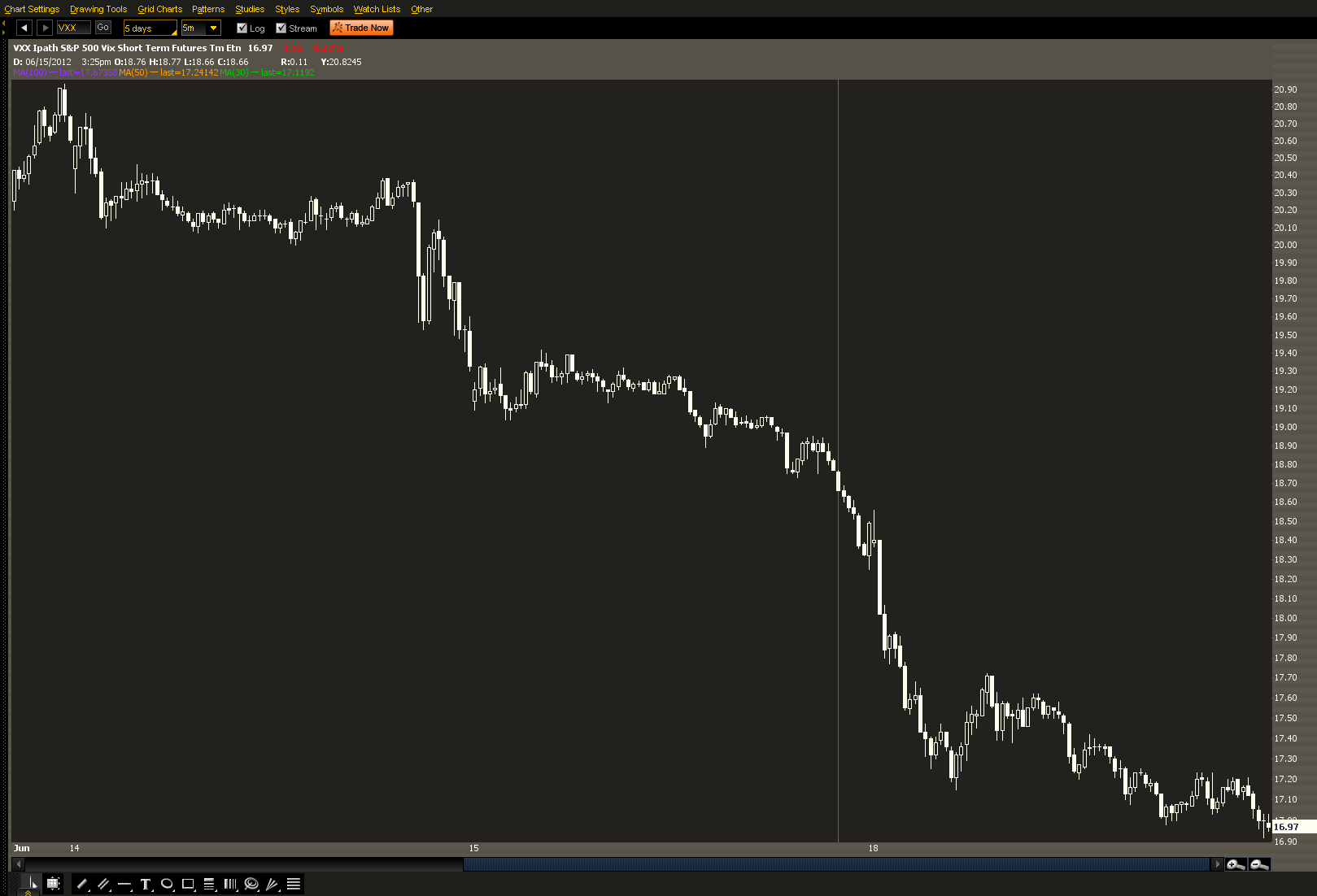After today’s market sell-off, the VIX rose a mammoth 35% and the VXX rose 10%. Two major global issues occurred today. The Malaysian Airline plane that was shot down, killing all on board, worried traders. In addition, Israel began a ground attack on Gaza. All of this led to the S&P 500 having its first down 1% in over 60 trading days and has given us another geopolitical crisis. What now?
Tag Archives: VIX
Playing Market Complacency With Volatility Option Spreads
By Chris Diodato
Just take a look at the VIX. Any expectation of a panic has essentially subsided. What does this mean for traders? Index options, generally used for hedging, have zero demand, so option sellers are asking for very low prices. We know that implied volatility is a mean reverting animal, so we would expect low volatility to move to high volatility in the future. An increase in implied volatility would increase the value of all options, giving option holders an additional "expected volatility" profit.
How can we take advantage of this? Capital intensive debit strategies. At this point, not 100% certain of the short term direction of the market, I suggest using spreads and straddles. These strategies profit from a large price move in the underlying. As long as price moves, and moves far, the straddle or strangle holder will make money. Therefore, the payoff looks like this.

From a traditional standpoint, there are several problems with this trade. Let's use an October 2013 SPY 141 straddle for example. SPY is currently trading slightly below 141.
- The S & P 500 would have to drop to around 1340 or climb to 1485 for us to break even!
- Time decay will give us a $5.50 loss every day, making us handle losses even if we are right!
The solution; stop making this a trade about price movement, and make it one about volatility. Before even explaining, we need to make a commitment that we will not hold this trade until expiration, or even close to expiration. For any expiration date, an increase in implied volatility to the levels in early May 2012 would give at least a 25% return on any of the at the money straddles. So, assuming volatility will increase in the future, here's the trade.
- Options that expire in a long time will increase the most when implied volatility increase (VEGA). Therefore, we should focus on a long-term straddle.
- Options that expire later also have less time decay in the short term.
- A good trade that avoids too high of a bid-ask spread while reaping these benefits seems to be the June 2013 SPY 141 straddle.
Here's the plan. The cost of the trade is about $20.13 per share. If price breaks to the upside, surging above the April highs, exit, since volatility will likely decline enough to offset any profits from the price movement. Otherwise, our time stop is September 20 if it does not become profitable, which will give a maximum net loss around 7% (I chose those to fit within my risk parameters. You may choose what suits you best). The key is not to hold this trade for a long time, since theta will eventually eat away any profit or magnify any loss.
June 22nd Option Market Recap – SPY, VIX, MA, FB, BBBY, FCX
June 22nd Option Market Recap - SPY, VIX, MA, FB, BBBY, FCX
In-VIX-ible
The VIX in simplest terms is the price people are willing to pay for a call or put option on the S&P 500. The higher the price the higher the VIX goes. Most people signify a rise in the VIX as a sign that the market is about to fall off a cliff, but that isn’t entirely true. While a rise in the VIX in the past has been a sign of future turmoil in the markets, much like we saw in late 2008 and 2009, if market participants are expecting a big move higher they will be less likely to write calls without first receiving a greater premium. This will also cause the VIX to rise, so you can have the VIX rise in rising markets as well.
Today the VIX dropped below the key 20 figure and then continued to fall, down over 13% after the close. The VXX ,an ETN that tracks VIX short term futures, collapsed as well down over 8%. While the decline could be attributed to the, not so catastrophic, results out of the Greek elections. I think there is more at play here than simply downside protection being unwound. I'll have more on that a little later.
Are we really out of the woods yet? Nothing was fixed. Spain 10 year bonds soared over the key 7% figure. Italy bonds are creeping higher as well. Greece is just a drop in the bucket compared to Italy and Spain, yet the market seemingly just shrugged it off. With the VIX down dramatically today stocks, you would think, would have had a much better day. No fear usually means higher equity markets. With Treasuries offering little yield and the FED hell bent on sending everyone into risk assets, aka stocks, we should have seen stocks 1%-2% higher today, but we didn't. Why the big drop in the VIX? Look at the VXX chart heading into the big Greece vote. Retail was likely loading up on the calls thinking the VXX would spike today, yet it has done just the opposite. Go figure!
Central banks, namely the FED... their fingerprints remain all over this market. Their goal continues to be inflating asset prices and they will do so by any means possible. For those of you who don't know what I am implying follow this link.
The bottom line, and what people still refuse to accept, is that these markets will not crash again.... at least not right now. Those calling for a crash, or a massive decline weeks or even days ago, you haven't been following this blog and you will remain to be wrong. You don't have an understanding what/who is running these markets. We dropped 1,000 points on the DOW in seconds during the flash crash and magically recovered those losses? Who else would be backing up the truck after such a historic collapse in stocks? The bears have been fighting against this invisible hand since March 2009 and continue to lose.
The enemy has a credit card with no limit. They can print money out of thin air. They can walk through brick walls. Those in control of these markets are InVIXible. Fight them at your own monetary peril.


